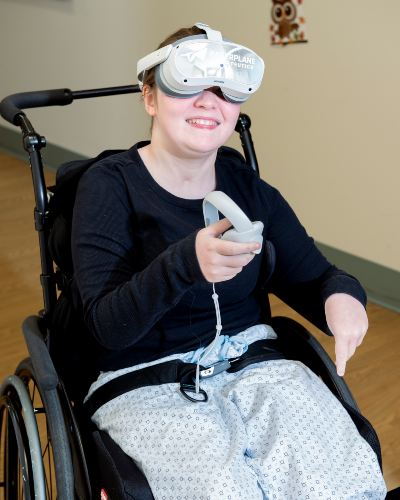
CHEO is expanding its use of virtual reality (VR) to help children and youth with cerebral palsy who struggle with anxiety when receiving intramuscular-administered medication, part of a multi-site study on the benefits of VR as a distraction tool.
Kids with cerebral palsy (CP), the most common childhood motor disability, face higher-than-normal muscle tone. One of the treatment methods is botulinum toxin, commonly known as Botox, which relaxes the muscles.
Needles aren’t easy for kids and this treatment has required sedation, which can have side effects and causes more fear and anxiety, according to Dr. Hana Alazem, a pediatric rehabilitation specialist at CHEO.
This becomes a core memory for her patients. Alazem and her team want to change the experience.
Along with CHEO fellow, Dr. Hedva Chiu, and interventional radiologist Dr. Gali Shapria, Alazem’s team is running a study in tandem with colleagues at Centre hospitalier universitaire Sainte-Justine and the Shriners Hospitals for Children in Montreal.
The study analyzes how a game played on a virtual reality headset can help distract patients and provide a more positive experience. At CHEO, it’s a collaboration between CHEO teams in Development & Rehabilitation and Medical Imaging.
Through a handful of appointments, the success rate is100 per cent, and that includes an appointment for a botulinum toxin injection for 12-year-old Keira Reaney.
 Keira was 15 months old when she contracted bacterial pneumococcal meningitis, which led to several strokes.
Keira was 15 months old when she contracted bacterial pneumococcal meningitis, which led to several strokes.
“She went back to ground zero ... the strokes pretty much impacted everything except for her body’s will to breathe on its own (she did need a tracheotomy), her heartbeat, her body’s ability to keep her air pumping, and her personality — the greatest gift,” said her mom, Emma Reaney.
Keira has spent a lot of time at CHEO, including CHEO School and Preschool until Grade 2, as she continues to rehabilitate.
Her mom calls her “a sprinkler of joy” who can draw people in. But sedation at prior appointments left her nervous, groggy and grumpy. The VR headset could be an effective long-term solution, said mom Emma, because injections are part of Keira’s ongoing treatment.
Before the procedure, Keira still expressed some hesitation as the VR headset was new and foreign. Her parents were also concerned because the VR game included shooting monsters, which can excite a patient. Excitability can trigger Keira’s dystonia, a movement disorder that causes muscles to contract.
She did it, though, and left the clinic room with a smile. It was a reminder of Keira’s ability to take on new challenges.
“I think Keira gets underestimated quite a bit,” said Emma. “You can never underestimate a kid.”
Emma said the VR headset de-medicalized the experience — from a surgery-type situation to a procedure — making the injections less invasive and disruptive to Keira and her family.
This study has tested VR on children as young as eight who receive botulinum toxin injections.
For CHEO’s medical teams, this type of intervention isn’t offered to all patients with cerebral palsy. It’s a more invasive treatment that takes several days to make an impact.
Alazem said clinicians will gather to decide who would benefit from each type of care in their journey to reach their respective rehabilitative goal.
The injections are important for patients like Keira. The VR headset allows her and other patients to receive the treatment while improving their memory of the experience.
This work marries research and clinical care, and it will soon become an important part of the new CHEO Integrated Treatment Centre with construction set to begin in 2025.





